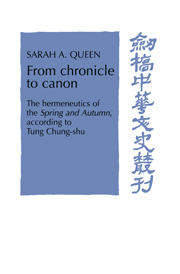Book contents
- Frontmatter
- Contents
- List of tables
- Acknowledgments
- List of abbreviations
- 1 Introduction
- PART I Three perspectives on the authenticity of the Ch'un-ch'iu fan-lu
- PART II Exegesis and canonization
- 5 The Spring and Autumn and Kung-yang tradition
- 6 Reforming the Ch'in laws
- 7 The wider circle of Han jurisprudence
- 8 Refashioning the imperial rites
- 9 Canon, cosmos, and court patronage
- 10 Conclusion
- Appendix 1 The birth and death dates of Tung Chung-shu
- Appendix 2 The dates of the Han-shu 56 memorials
- Appendix 3 Han transmission of Kung-yang learning
- Appendix 4 Han dynasty disciples of Tung Chung-shu
- Appendix 5 Citations and titles attributed to Tung Chung-shu
- Appendix 6 Transmission of Ch'un-ch'iu fan-lu editions
- Selected bibliography
- Index
8 - Refashioning the imperial rites
Published online by Cambridge University Press: 10 December 2009
- Frontmatter
- Contents
- List of tables
- Acknowledgments
- List of abbreviations
- 1 Introduction
- PART I Three perspectives on the authenticity of the Ch'un-ch'iu fan-lu
- PART II Exegesis and canonization
- 5 The Spring and Autumn and Kung-yang tradition
- 6 Reforming the Ch'in laws
- 7 The wider circle of Han jurisprudence
- 8 Refashioning the imperial rites
- 9 Canon, cosmos, and court patronage
- 10 Conclusion
- Appendix 1 The birth and death dates of Tung Chung-shu
- Appendix 2 The dates of the Han-shu 56 memorials
- Appendix 3 Han transmission of Kung-yang learning
- Appendix 4 Han dynasty disciples of Tung Chung-shu
- Appendix 5 Citations and titles attributed to Tung Chung-shu
- Appendix 6 Transmission of Ch'un-ch'iu fan-lu editions
- Selected bibliography
- Index
Summary
Tung Chung-shu's endeavors to refashion the imperial rites once again reflected his desire to rectify the abuses of the Ch'in dynasty. We have seen that shortly after Emperor Wu assumed the throne, Tung and several other scholars urged the emperor to reform the state's ceremonial practices based on the teachings of Confucius. Although they were initially blocked by the emperor's powerful grandmother, Empress Dowager Tou, following her death in 135 b.c.e. Emperor Wu was free to support this movement to remake the state religion. Thereafter, Confucian scholars, together with other influential court practitioners, competed to gain the emperor's patronage. They sought to institute policies consonant with their religious viewpoint and historical outlook – all the while strengthening their indispensable roles as overSeers of the state religion. In this respect, the ceremonial practices and norms that Tung and his disciples ascribed to the Spring and Autumn are particularly relevant.
For the purposes of the following discussion it is beneficial to differentiate two basic ways that interpretive communities assume their texts to be ritually significant. We may distinguish these two modes of reception as ‘first-order’ and ‘second-order’ liturgy. First-order liturgy plays a direct role in worship. For example, it may be read to or recited by a congregation, or its very presence may function as a powerful symbol of authority. Second-order liturgy does not play a direct role in worship; it is prescriptive. Such scriptures serve to codify ceremonial norms, whether describing specific rites or the attitudes that should ideally accompany them.
- Type
- Chapter
- Information
- From Chronicle to CanonThe Hermeneutics of the Spring and Autumn according to Tung Chung-shu, pp. 182 - 205Publisher: Cambridge University PressPrint publication year: 1996
- 1
- Cited by



